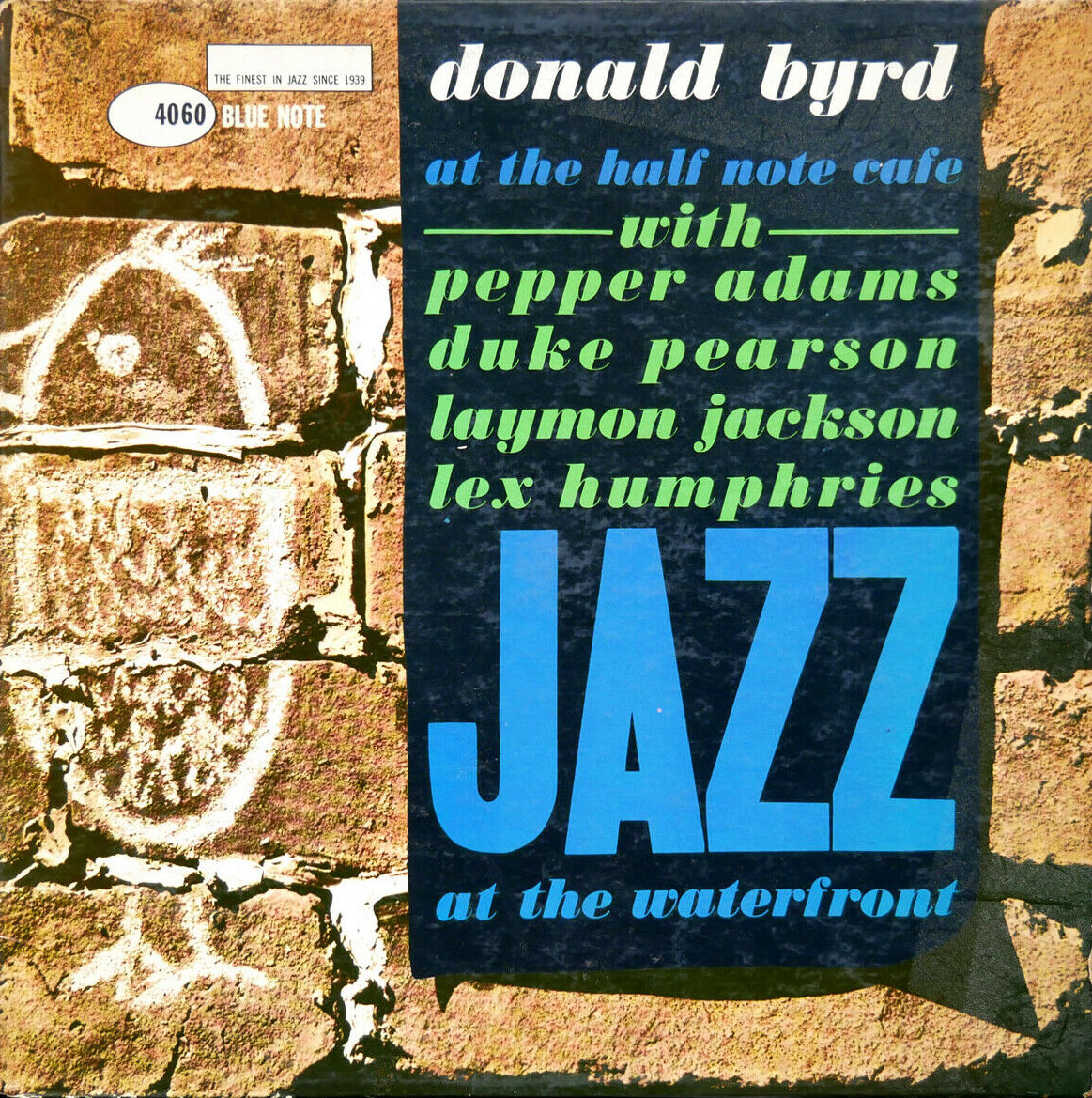Byrd’s band flies high at the Half Note Café.
Personnel
Donald Byrd (trumpet), Pepper Adams (baritone saxophone), Duke Pearson (piano), Laymon Jackson (bass), Lex Humphries (drums)
Recorded
on November 11, 1960 at the Half Note Café, NYC
Released
as BLP 4046 and BLP 4061 in 1961
Track listing
Volume 1:
Side A:
My Girl Shirl
Soulful Kiddy
Side B:
A Portrait Of Jennie
Cecile
Volume 2:
Side A:
Jeannine
Pure D. Funk
Side B:
Kimyas
When Sunny Gets Blue
From A Night At Birdland by Art Blakey & The Jazz Messengers to Live At The House Of Tribes by Wynton Marsalis, Blue Note has produced an iconic series of cookin’ live albums. Not counting the wide array of live performances that Blue Note had its hands in ever since, so far culminating in 8:Kindred Spirits, superb and poetical date from Charles Lloyd, former Cannonball Adderley Quintet band member.
Six years into Blue Note’s outstanding live recording streak, the company released Donald Byrd’s At The Half Note Café Volume 1 & 2 in 1961, essential live Blue Note, punchy as hell, clear and broad sound scape, plainly gorgeous.
How did Rudy van Gelder pull it off? Well, he set up some gear and let the tapes roll. Presumably, acoustics were fine. Ace mastering at Englewood Cliffs, New Jersey was the icing on the cake. I read somewhere that The Blackhawk in San Francisco was one of the dingiest and sleaziest clubs around. And that’s a statement. Yet, the Thelonious Monk and Miles Davis recordings sound superb. Don’t know where the Half Note Café at 298 Hudson Street in Greenwich Village in New York City stood as far as sleaze is concerned. However, its reputation among musicians was good. Nice atmosphere, hip crowd. Listen to Byrd’s band. Just one night out of many in the early 1960’s, hard bop the omnipresent style even if new concepts have importantly entered the equation, one week the club presents Lee Morgan, the other week Stanley Turrentine, Kenny Dorham, Cecil Payne, Barry Harris, Yusef Lateef, Jimmy Knepper or Dave Pike. Etc. And.
Byrd’s band’s cookin’ and if you want an aural definition of hard bop, it’s right there. That’s Donald Byrd, who came into his own in the mid-and late 1950’s as one of the bright and sassy trumpeters of his generation, notably as a member of Art Blakey & The Jazz Messengers. By 1960, Byrd was into a run of excellent Blue Note albums. He played with monster baritone saxophonist Pepper Adams for a number of years, which led to a live LP on Riverside, From Ten To Four At The Five Spot (talkin’ about dingy and hip) and various excellent Blue Note LP’s from 1959 to 1962. The rhythm section consists of pianist and Blue Note A&R man Duke Pearson, bassist Laymon Jackson and drummer Lex Humphries, who already shared collaborations on records between them.
Since the double CD set and streaming, Donald Byrd’s show can be heard in its entirety, adding Between The Devil And The Deep Blue Sea, Theme From Mr. Lucky, Chant and Child’s Play. Potentially, this could’ve been a solid Vol. 3, which evidently speaks volumes about the quality of Byrd’s group. It’s hot, soulful, smooth and swinging. In the past, references about Byrd’s ‘manicured licks’ have been made on All Music which probably refer to Byrd’s repetitive blues phrases on Jeannine. Nonsense. Although hardly innovative, Byrd uses repetition in his game of tension and release, slightly variating with bending, stretching and timing notes.
Duke Pearson’s Jeannine is a winner and typical of Byrd’s Half Note sets, tight-knit and passionate. It’s also typical in that apart from When Sunny Gets Blue, all titles are original compositions by Donald Byrd and Duke Pearson. A couple of good ones, folks, featuring the up-tempo cooker My Girl Shirl, catchy mid-tempo blues line Soulful Kiddy, shimmering ballad A Portrait Of Jenny, happy-go-lucky and bouncy Cecile, down-home slow blues Pure D. Funk and rousing Latin-tinged Kimyas.
With time to stretch out, there’s plenty to enjoy in the way of soloing and all three participants come up with the goods. Byrd is mightily inspired by the powerful rhythmic stimulus of Kimyas, eagerly getting into the groove like a talented teenage bat man that can’t wait to get on the field. The architecture of the solos by the barking and booming Pepper Adams, who single-handedly raised playing of the baritone saxophone to the next level, is something else, notably demonstrated during Cecile.
By 1960, people finally had a chance to hear extended story telling by Duke Pearson, whose soulful and well-constructed variations on Jeannine should not go unnoticed. Just a few highlights, there are stand out moments throughout. Drummer Lex Humphries constantly stokes up the fire, alertly and richly accentuating shifts and changes. Above all, At The Half Note Café Vol. 1 & 2 testifies to the rapport between members of a well-oiled, hard-swinging machine.


